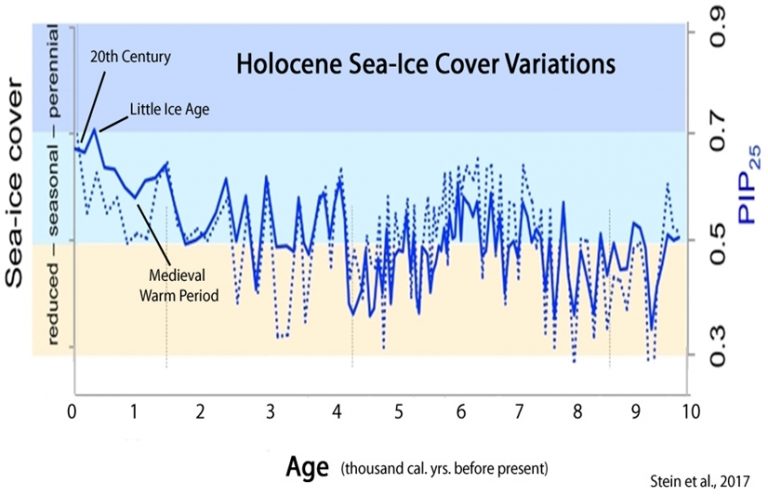Stop ducking what? Your fantasies? What data do you have? Zip. You have no idea what the impact of that climate was on polar bears. And, as I stated, it took thousands of years to get through those changes. That allows time to adapt, to relocate, to evolve. Your belief that it is applicable to today's circumstance is willful blindness.
Still you don't address it, still no evidence to support it comes from you...….
Here is a chart based on the Greenland Ice core for the region, showing significant variability.
LINK
I have posted published papers about little to NO Summer ice right here in the forum a few times already.
Journal of Quaternary Science
Holocene variability in sea ice cover, primary production, and Pacific-Water inflow and climate change in the Chukchi and East Siberian Seas (Arctic Ocean)
Ruediger Stein,et al
Version of Record online: 27 FEB 2017
ABSTRACT
In this study, we present new detailed biomarker-based sea ice records from two sediment cores recovered in the Chukchi Sea and the East Siberian Sea. These new biomarker data may provide new insights on processes controlling recent and past sea ice changes. The biomarker proxy records show (i) minimum sea ice extent during the Early Holocene, (ii) a prominent Mid-Holocene short-term high-amplitude variability in sea ice, primary production and Pacific-Water inflow, and (iii) significantly increased sea ice extent during the last ca. 4.5k cal a BP. This Late Holocene trend in sea ice change in the Chukchi and East Siberian Seas seems to be contemporaneous with similar changes in sea ice extent recorded from other Arctic marginal seas. The main factors controlling the millennial variability in sea ice (and surface-water productivity) are probably changes in surface water and heat flow from the Pacific into the Arctic Ocean as well as the long-term decrease in summer insolation. The short-term centennial variability observed in the high-resolution Middle Holocene record is probably related to solar forcing. Our new data on Holocene sea ice variability may contribute to synoptic reconstructions of regional to global Holocene climate change based on terrestrial and marine archives.

LINK
The words, Medieval Warm Period, Little Ice age, 20th Century were added onto the chart above by Kenneth Richards.
Your claim of warming rate is greater now than during early party of the Holocene is patently absurd and the CURRENT rate are similar to past periodic warming rates back to the mid 1800's. Told you that several times that too, yet you persist in your fantasy.
Q&A: Professor Phil Jones
"A - Do you agree that according to the global temperature record used by the IPCC, the rates of global warming from 1860-1880, 1910-1940 and 1975-1998 were identical?
An initial point to make is that in the responses to these questions I've assumed that when you talk about the global temperature record, you mean the record that combines the estimates from land regions with those from the marine regions of the world. CRU produces the land component, with the Met Office Hadley Centre producing the marine component.
Temperature data for the period 1860-1880 are more uncertain, because of sparser coverage, than for later periods in the 20th Century. The 1860-1880 period is also only 21 years in length. As for the two periods 1910-40 and 1975-1998 the warming rates are not statistically significantly different (see numbers below).
I have also included the trend over the period 1975 to 2009, which has a very similar trend to the period 1975-1998.
So, in answer to the question, the warming rates for all 4 periods are similar and not statistically significantly different from each other.
Here are the trends and significances for each period:"
LINK
You suffer from serious memory problems?





